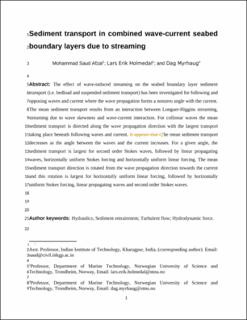| dc.contributor.author | Afzal, Mohammad Saud | |
| dc.contributor.author | Holmedal, Lars Erik | |
| dc.contributor.author | Myrhaug, Dag | |
| dc.date.accessioned | 2021-09-21T11:19:27Z | |
| dc.date.available | 2021-09-21T11:19:27Z | |
| dc.date.created | 2021-01-26T22:28:42Z | |
| dc.date.issued | 2021 | |
| dc.identifier.citation | Journal of Hydraulic Engineering. 2021, 147 (4), . | en_US |
| dc.identifier.issn | 0733-9429 | |
| dc.identifier.uri | https://hdl.handle.net/11250/2779841 | |
| dc.description.abstract | The sediment transport in the seabed boundary layer due to wave-induced streaming has been investigated for nonzero angle between the current and the waves. The mean sediment transport is a result of interaction between streaming due to wave skewness, the Longuet-Higgins streaming, and the wave–current interaction. For colinear waves, the mean sediment transport is directed along the wave propagation direction, with the largest transport taking place beneath the waves propagating in the direction of the current. Mean sediment transport decreases with increasing angle between the current and the waves. For a particular angle, the mean sediment transport beneath second-order Stokes waves is largest and decreases in the following order: linear propagating waves followed by horizontally uniform Stokes forcing and smallest for horizontally uniform linear forcing. The direction of the mean sediment transport is rotated toward the current away from the direction in which the wave propagates. The magnitude of rotation is smallest for second-order Stokes waves and increases in the following order; linear propagating waves followed by horizontally uniform Stokes forcing, and largest for horizontally uniform linear forcing. | en_US |
| dc.language.iso | eng | en_US |
| dc.publisher | American Society of Civil Engineers (ASCE) | en_US |
| dc.title | Sediment Transport in Combined Wave–Current Seabed Boundary Layers due to Streaming | en_US |
| dc.type | Peer reviewed | en_US |
| dc.type | Journal article | en_US |
| dc.description.version | acceptedVersion | en_US |
| dc.rights.holder | This material may be downloaded for personal use only. Any other use requires prior permission of the American Society of Civil Engineers | en_US |
| dc.source.pagenumber | 15 | en_US |
| dc.source.volume | 147 | en_US |
| dc.source.journal | Journal of Hydraulic Engineering | en_US |
| dc.source.issue | 4 | en_US |
| dc.identifier.doi | 10.1061/(ASCE)HY.1943-7900.0001862 | |
| dc.identifier.cristin | 1879988 | |
| cristin.ispublished | true | |
| cristin.fulltext | preprint | |
| cristin.qualitycode | 2 | |
